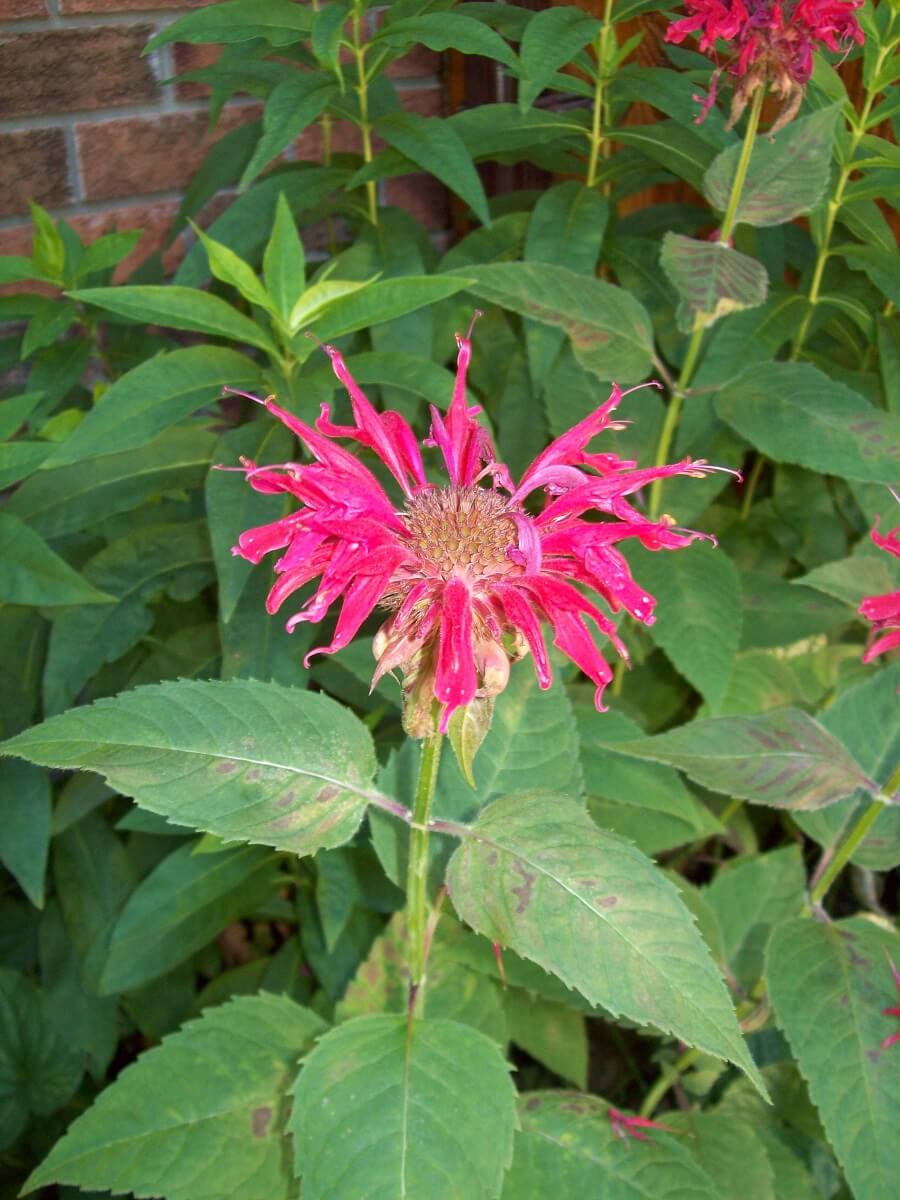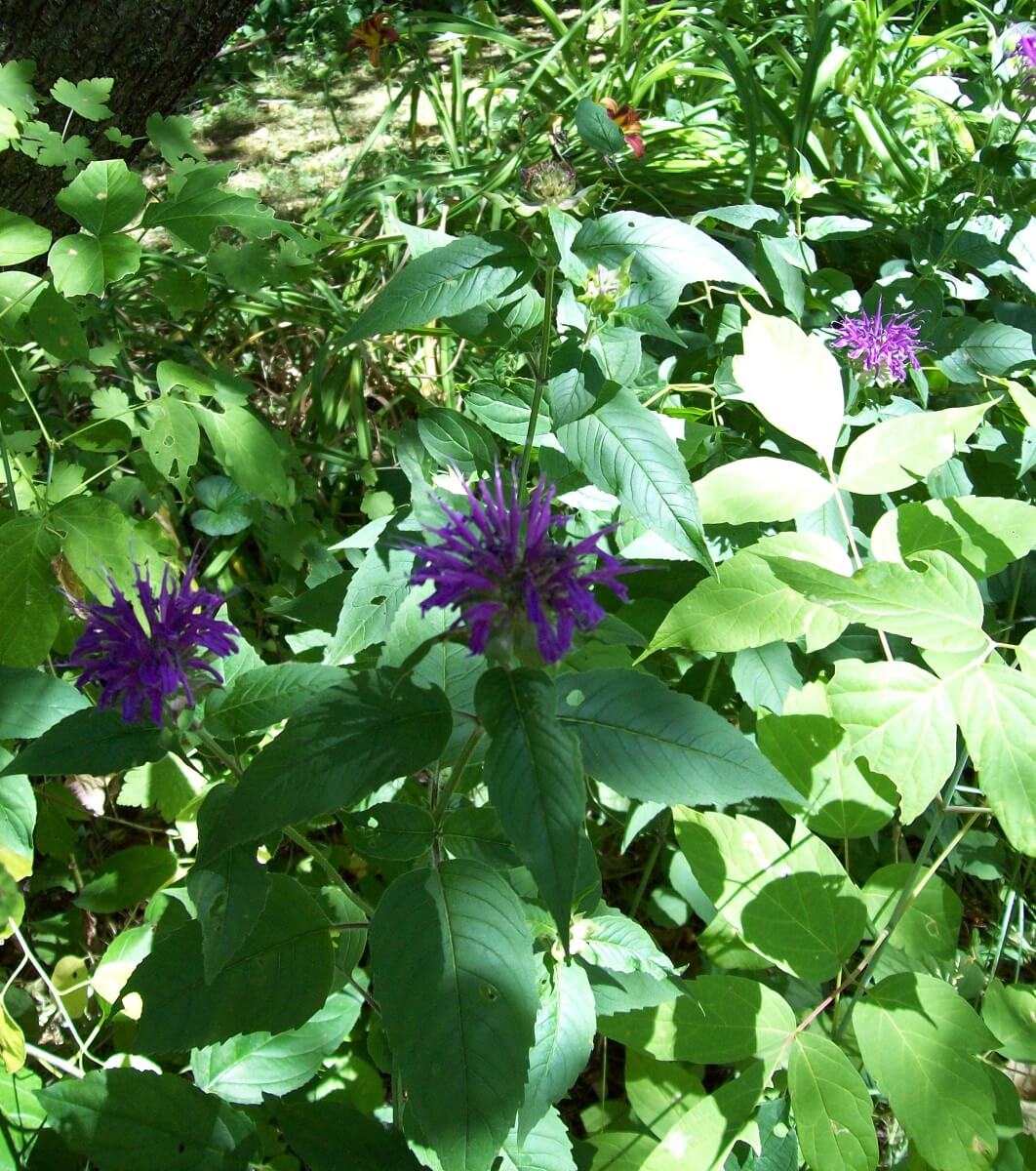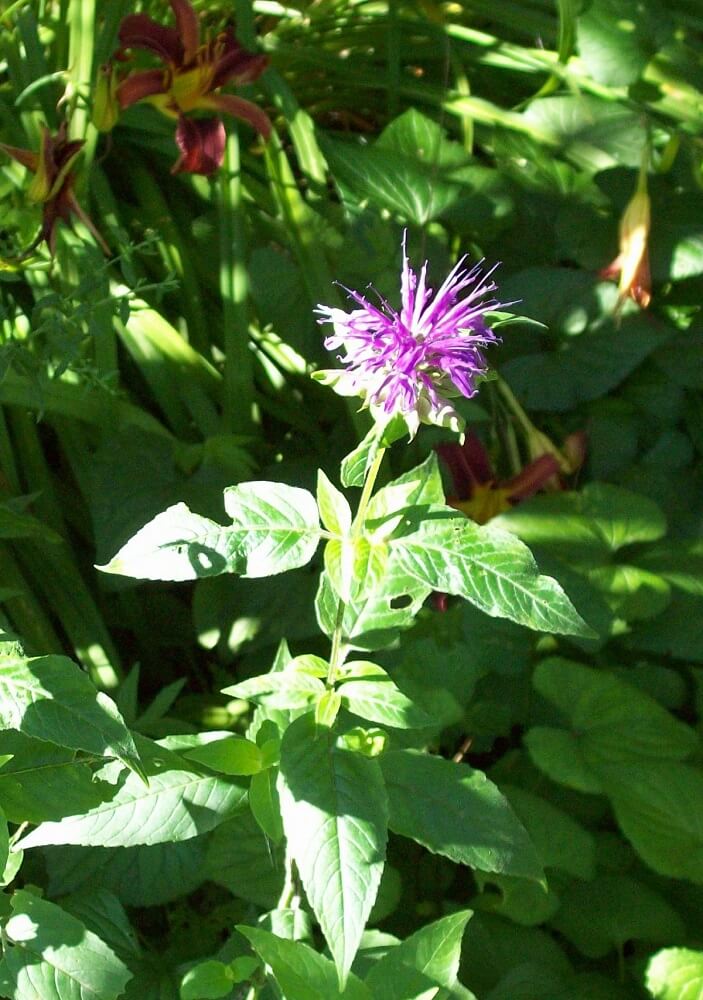“Mom,” my six-year-old called from the front walk where he had been riding his bike back and forth. He had paused in front of my display of red and purple, firework-like flowers and admired them. At an age where he wanted to know everything, it wasn’t unexpected that he would ask about the different flowers in my garden.
I looked up from the other end of the garden where I had been pulling up the weeds. “Yes, dear?”
“What are these called?” He was obviously fascinated by the flower, its vibrant color and unusual shape.

“Bee balm,” I said, choosing one of the easier names to identify the plant, knowing the other names, like bergamot, monarda, horsemint, or oswego tea might sound too abstract and lose something in the translation. Even the fact that it was part of the flowering plants of the mint family, Lamiaceae, a North American genus, would be lost on my son’s young mind. He was obviously captivated by the simple bee balm name, so may as well stick with it.
“Bee bum?” He gave me that look. “Really?”
I tried to correct him, then gave up. If he wanted to call it a bee bum, who was I to argue? The plant was a good pollinator, after all, and it did attract a lot of bees. And hummingbirds. Until I had a healthy patch of bee balms in my garden, I hadn’t been privileged with the appearance of a hummingbird. Now, even in my tiny garden in the busy suburb, hummingbirds were attracted to my bee balms. Delightful to watch.

One flitted past my son and made for one of the flowers, hovering as it stuck its long, pointed beak into the heart of the red puff.
“Is that a hummingbird?” my son asked, equally fascinated as I was.
I nodded my head. “It likes the nectar of bee balms.”
“And there’s a bee, too, Mom.” He pointed. “Now I know why it’s called a bee bum. Because bees like to bum around them.”

I chuckled and returned to my weeding; my son resumed biking up and down the drive.
That fond memory has stayed with me. When I moved to the country, I had to bring my bee balms (or bums) with me. I knew they would do well. And I was hoping they would attract lots of hummingbirds. Over the years, my bee balms have spread around my property, and I’m glad to say that the hummingbirds, the butterflies, and the bees enjoy the healthy flowers every July.
Bee Balm: A Hardy Perennial
Bee balms, with their whorled flowers, come in red, fuchsia purple, pink, and white. Grown well in soil that’s too wet or too dry, it’s a sturdy, spreading perennial that survives in many extreme conditions. I’ve had numerous seasons of drought, and although the leaves droop from lack of water, the flowers survive and continue to multiply.
I’ve also had seasons of too much rain, with flood-like conditions, and the bee balm has survived. In fact, the last season that was too wet, we had numerous double headed bee balms.
https://www.instagram.com/p/BljZwCcHd3D/?tagged=beebalm
Since bee balm multiplies and spreads well, it’s a good plant to share with friends and transplant to different areas of the garden. My first bee balm was a gift from a friend. It started with a small patch in my urban garden, many of which I transplanted to my country property.
I have both the purple and the red varieties, and they have managed to spread throughout my many garden areas, surviving both droughts and floods. I enjoy watching the hummingbird, in particular, as it sucks the nectar from one bee balm flower after another.
A Beneficial Addition For Pollinators
The bee balms not only grow in different colors, they also grow to different sizes. The red is usually the bigger of the varieties. Perhaps that’s why the hummingbirds enjoy my red bee balms more than my purple, which is a smaller perennial. Since the plant is a good pollinator, it makes a good companion plant for other plants, like squash, that depend on the bees for pollination.
https://www.instagram.com/p/BlkpTr1gmRN/?tagged=beebalm
And while it attracts the pollinators, it resists the more destructive animals like rabbits and deer. Don’t get me wrong. I do love watching the elegant deer grazing in the fields and bounding through the woods, and the rabbits, especially the large jackrabbits, hopping around, but I don’t appreciate their ability to demolish an entire garden (usually mine) with great relish.
Bee balm is easy to grow, and it spreads through rhizomes (underground stems) beneath the soil. The plant loves the sun, but it can also tolerate partly shady areas, which is a good thing since most of my garden area is surrounded by groves of trees. It’s an easy plant to grow and maintain, but it does have issues like most other plants.
Powdery Mildew Problems
In the hot, humid weather of its June to late-summer growing season, the leaves often become dotted with powdery mildew, a white dust on the lower and middle leaves. It can cause deformation of the plant, defoliating it of leaves and leaving behind barren stems.
https://www.instagram.com/p/Bk53GkrAkSs/?tagged=powderymildew
Although there’s not much that can be done to prevent this mildew, removal of the infected foliage will help prevent it from spreading. If the plant is in an area with good air circulation, you’ll have less mildew. Sadly, you may never eliminate it completely; but unsightly as a mildew-infested bee balm might be, the mildew won’t kill the plant, and it will continue to grow year after year.
Bee Balm Uses
Since it’s a major pollinator and attracts pollinating insects and birds, it’s not surprising that bee balm has some medicinal and edible attributes for humans as well. The petals from the flowers (though not the entire flower head) are edible and make a colorful garnish for salads. They can be used fresh or dried in both salads and cooked foods.
The leaves can be brewed into a very aromatic tea. It is commonly used as a cure for colds, but it’s also a good treatment for headaches, fever, sore throats, and gastric disorders. There are many other uses for bee balm preparations in alternative medicine, including a medicinal application for skin infections. The fragrant leaf and flower make it a good herb when dried for potpourri and sachets. The entire flower also dries well for dried flower arrangements.
https://www.instagram.com/p/BljkkmzliN_/?tagged=beebalm
Personally, I’m more interested in the beauty of this flower, one that blooms for most of the summer, than in its culinary and medicinal benefits. The vibrant colors remind me of a display of fireworks on a clear summer night. The fact that it attracts a great army of pollinators is an added bonus.
During a wetter-than-usual summer, you might even get lucky enough to see some rare double-headed bee balm – bonus! Plant the bee balms with equally colorful and prolific coneflowers and evening primrose, as I have done, and you’ll have an instant collage of color and diversity with the benefit of easy care.









































As a new gardener, I don’t know what to do with the plants after summer. Do I pull them up or cut off the spent growth or what?!
perplexed in Pa
Kate
Photo/Attachment:
I leave the garden cleanup till spring. The flowers will then re-seed and the added benefit is that the flower stalks will provide shelter for pollinators like honeybees.
It’s was great hearing about double headed bee balm I noticed them last year and I have more coming this year they are beautiful
I planted a pkt of Bee Balm plants in pot and haven’t been blessed with any flowers yet. They were planted in May or beginning of June. They’re growing and leggy but no blooms. They get sun for a be out 4 and a half hrs. Could that be why?
Hello Karen – Bee Balms don’t do very well in pots. They should be planted right in your garden.
The Bee Balm Seeds that I planted at my Daughter’s home last year grew alongside Batchelors Buttons in a large “Barrell half” pot. Both grew well, but the Bee Balm never developed any blooms. They grew leaning toward the front of their house (a Bush was blocking the natural light.) The Bush was 1/2 dead (2 planted together & 1 was dead) This Spring we cleaned out that area & trimmed the remaining bush…and the Bee Balm took off! It is probably ~3 feet tall and have HUGE Buds. I can’t wait for them to open. Unfortunately, the Batchelor Buttons got crowded out!
Hi, I have those same dark brown splotches on my Monarda leaves that are shown in your second photo. Do you know what causes this? If I don’t pluck the leaves showing these splotches, it spreads quickly, the leaves turn black, shrivel and fall off. I have searched the web and your photo is the only one I’ve found with the same splotches. They look like the leaf is starting to burn.